MIO OBSERVATION PROGRAM
JULIO : Judicious Location for Intrusion Observation
|
PIs: Anne Petrenko and Jean-Luc Fuda
|
(2012-16: Anne Petrenko and Gilles Rougier)
|
43.142° N - 5.233° E
|
43° 08.52’ N - 05° 14.02’ E
|
Note: se prononce JULIO = JULIE-O
en hommage au travail précurseur de JULIE Gatti (thèse 2008; voir bibliographie)
|
Introduction
|
The Mediterranean Institute of Oceanology has undertaken since 2001 a program of observation of the intrusions of the northern western Mediterranean current (generally referred to as Northern Current) in the Gulf of Lion (Gatti, 2008 ; Petrenko et al., 2013) . These intrusions are generally associated to to wind forcings : either northerlies (Mistral) or south-easterlies (Barrier et al., 2016). Recently, a RFA algorithm using altimetry data has been developed to detect these intrusions with satellite data (Casella et al., 2020). These intrusions can have strong impacts on the biogeochemical budget offshore Marseille.
Currently, the JULIO station consists of a bottom ADCP moored at ~100m depth, near the boundary of the marine National Park of Calanques. It measures oceanic currents every 1/2h every 5 m of the water column. Regular cruises (during the programs SPECIMED, ROMARIN and VVP-tests) make additional measurements at JULIO. For example, vertical velocities are measured during the VVP-tests. It will also be a crucial point in the near future as a test point of the SWOT mission.
|
On the eastern side of the gulf, during specific conditions, a vein of the Northern Current can intrude on the shelf .
Both in situ measurements and numerical modelling show that intrusions develop either as a part of the NC itself encroaching on the shelf or as a separated branch of the main vein of the NC
(Gatti, 2008 ; Petrenko et al., 2013). These two types of intrusions can change from one type to the other, both in time and in space.
Three kinds of wind events are likely to generate intrusions: the Mistral cessations, episodes of inhomogeneous Mistral or periods of East winds.
In the first two cases, intrusions are due to the inhomogeneity of the wind event.
The intrusions during East wind could be due to two processes: the Ekman drift and the shift of the current’s core towards the coast.
Otherwise, intrusions cannot develop during homogeneous Mistral.
Other factors, such as the vertical and horizontal extents of the NC as well as its degree of mesoscale instability, can also influence the development of intrusions.
However, neither the NC seasonal variability nor the variation of the GoL’s water budget have an impact on the occurrence of intrusions.
|
Methods
Situated on the 100 m-deep isobath, the JULIO bottom-moored ADCP measures horizontal currents through the water column, to detect intrusions occurring upstream and on the eastern side of the Gulf of Lion.
The ADCP (RDI Ocean Sentinel 300 kHz) provides a current time series every ½ hour and every 5m depth (4 m until 2016) throughout the water column.
Last launching on January 24, 2025 from Research Vessel Antedon II, with a new ADCP Teledyne Sentinel V50, 5 beams, 500kHz, bought in 2024 (SERCO cooperation, IDEAS-QA4EO, PI L. Rousselet).
Seven time series are available :
* from July 12, 2023 to May 23, 2024, every 30', every 2.5 m
* from June 24, 2022 to June 22, 2023, every 30', every 2.5 m
* from Sept 1st, 2021 to June 23, 2022, every 30', every 4 m
* from Dec 7, 2020 to August 31, 2021; every 30', every 5 m Small movie of the launching
[Sept 23, 2016 launch. Dragged probably 3 days after, but stayed at the bottom. ADCP found mid-April 2017 by fishermen. ADCP ok but cage not responding to acoustic communication tests.]
* from July 17, 2014 to April 10, 2015
* from Sep. 26, 2013 to March 28, 2014
* from Feb. 12 to Oct 23, 2012
Localization of JULIO since 2020: 5°14.02' E - 43°8.52' N or 5.233° E - 43.142° N
Localization of JULIO from 2012 to 2016: 5° 15.28' E – 43° 8.15' N or 5.255°E – 43.135°N
To obtain JULIO time series, ypu can download them on the SEANOE database:
Site SEANOE - JULIO data
Special thanks to Céline Quentin, Nicolas Barrier and Maurice Libes for their work.
Bibliography:
- Casella, D., Meloni, M., Petrenko, A.A., Doglioli, A.M., Bouffard, J. (2020). Coastal current intrusions from satellite altimetry. Remote Sens., 12(22), 3686; doi:10.3390/rs12223686.
hal-02999636
popularization web paper |
- Casella D., Meloni M., Petrenko A., Doglioli A.M., Bouffard J., (2020)
Toward a New Coastal Altimetry-Based Algorithm for the Detection of Current Intrusions Into the Gulf of Lion.
12th Coastal Altimetry Workshop, Coastal Altimetry Training, 4-7 February 2020, ESA-ESRIN, Frascati (Rome), Italy. |
- Meloni, M., Bouffard, J., Doglioli, A.M., Petrenko, A.A., Valladeau, G. (2019). Toward science-oriented validations of coastal altimetry: application to the Ligurian Sea.
Remote Sens.Envir., 224, 275-288, doi:10.1016/j.rse.2019.01.028.
see preprint HAL
|
- Meloni M., Doglioli A., Petrenko A., Bouffard J., Valladeau G. (June 18), Multi-Scale Analysis and Applications of Coastal Altimetry Observations Over the Ligurian Sea. 11th Coastal Altimetry Workshop, Frascati, Italy.
Abstract
|
- Millet B, Pinazo C, Banaru D, Pagès R, Guiart P, et al. (2018) Unexpected spatial impact of treatment plant discharges induced by episodic hydrodynamic events: Modelling Lagrangian transport of fine particles by Northern Current intrusions in the bays of Marseille (France). PLOS ONE 13(4): e0195257. https://doi.org/10.1371/journal.pone.0195257 |
- Bouffard J., Meloni M., Fernandes J., Lázaro C., Casadio S., Doglioli A.M., Petrenko A., Femenias P. (Feb 2017), Coastal Altimetry in Support to Marine Observatory and Marine Observatory in Support to Coastal Altimetry: Multi-Platform Validations of Altimetry for Monitoring the Variability of Coastal Fronts. 10th Coastal Altimetry Workshop, Florence, Italy.
Abstract Book |
- Barrier N., Petrenko A.A., Ourmieres Y., (2016), Strong intrusions of the Northern Mediterranean Current on the eastern Gulf of Lion: insights from in-situ observations and high resolution numerical modelling, Ocean Dynamics, 1-15. 10.1007/s10236-016-0921-7. (see Publications section of Petrenko homepage to download paper) |
- Declerck A., Ourmieres Y. and Molcard A. (2016), Assessment of the coastal dynamics in a nested zoom and feedback on the boundary current: the North-Western Mediterranean case. Ocean Dynamics, final revision
|
- Ross O.N., M. Fraysse, C. Pinazo, I. Pairaud (2016), Impact of an intrusion by the Northern Current on the biogeochemistry in the eastern Gulf of Lion, NW Mediterranean. Estuarine, Coastal and Shelf Science 170(1–9). doi:10.1016/j.ecss.2015.12.022
|
- Petrenko, A.A., , Kersale, M., Nencioli, F., Gatti, J., Doglioli, A. M., Dekeyser, I. (2013), Coastal circulation in the Gulf of Lion, the influence of mesoscale processes on interregional exchanges, Proceedings, 40th CIESM Congress, 28 October - 1 November 2013, Marseille, France
|
- Fraysse, M., Pinazo, C., Faure, V.M., Fuchs, R., Lazzari, P., Raimbault, P. Pairaud, I (2013), Development of a 3D coupled physical - biogeochemical model development around Marseille coastal area (NW Mediterranean Sea): What complexity is required in coastal zone?, PlosOne, doi: 10.1371/journal.pone.0080012
|
- Gatti, J., Intrusions du Courant Nord sur la partie Est du plateau continental du golfe du Lion, thesis, June 2008, 156 pp.
|
- Petrenko A., Y. Leredde, and P. Marsaleix (2005), Circulation in a stratified and wind-forced Gulf of Lions, NW Mediterranean Sea: in-situ and modeling data. Continental Shelf Res., 25, 5-27, doi:10.1016/j.csr.2004.09.004
|
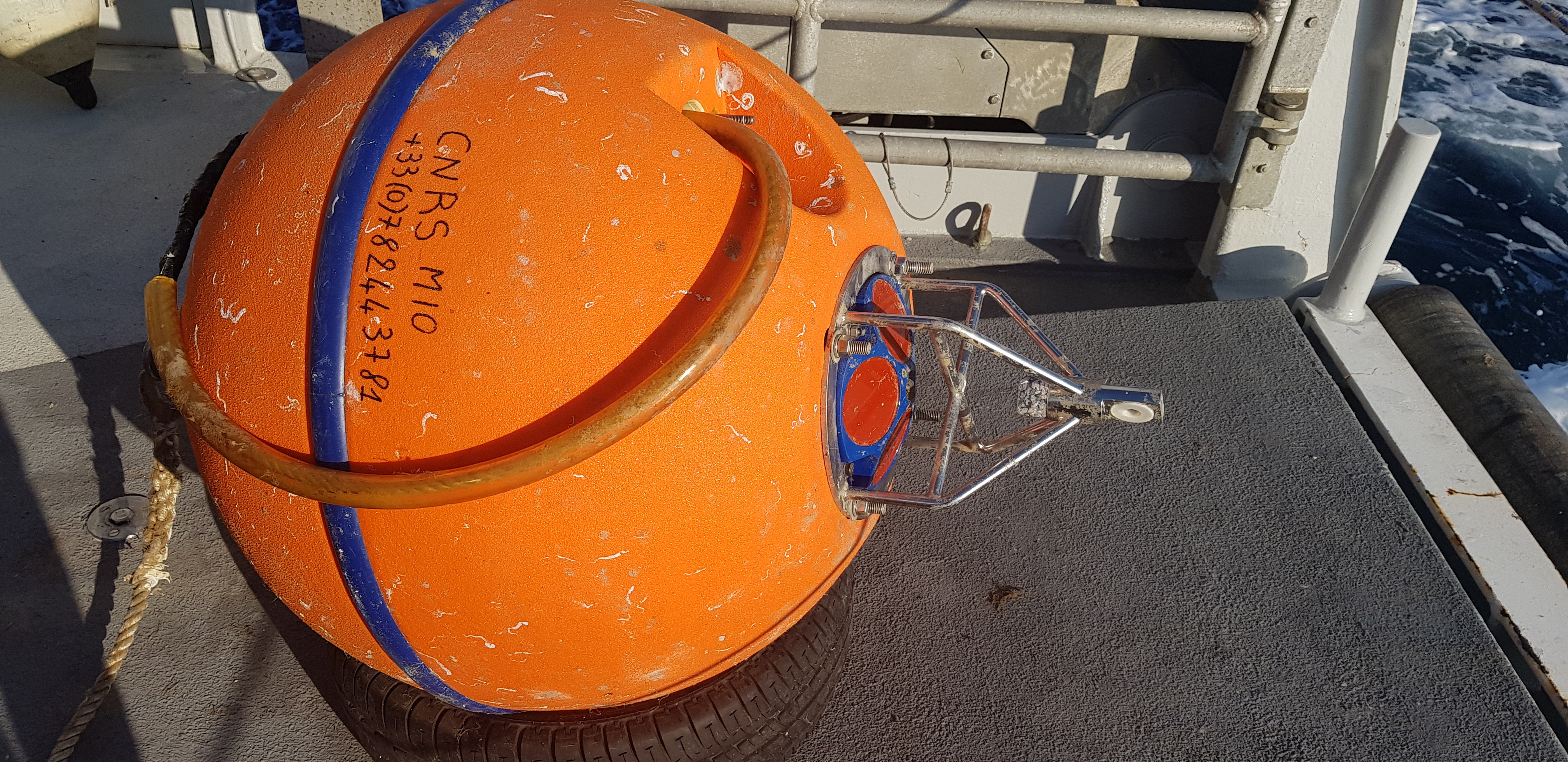
Ready to be launched Sept 1st, 2021
|
|
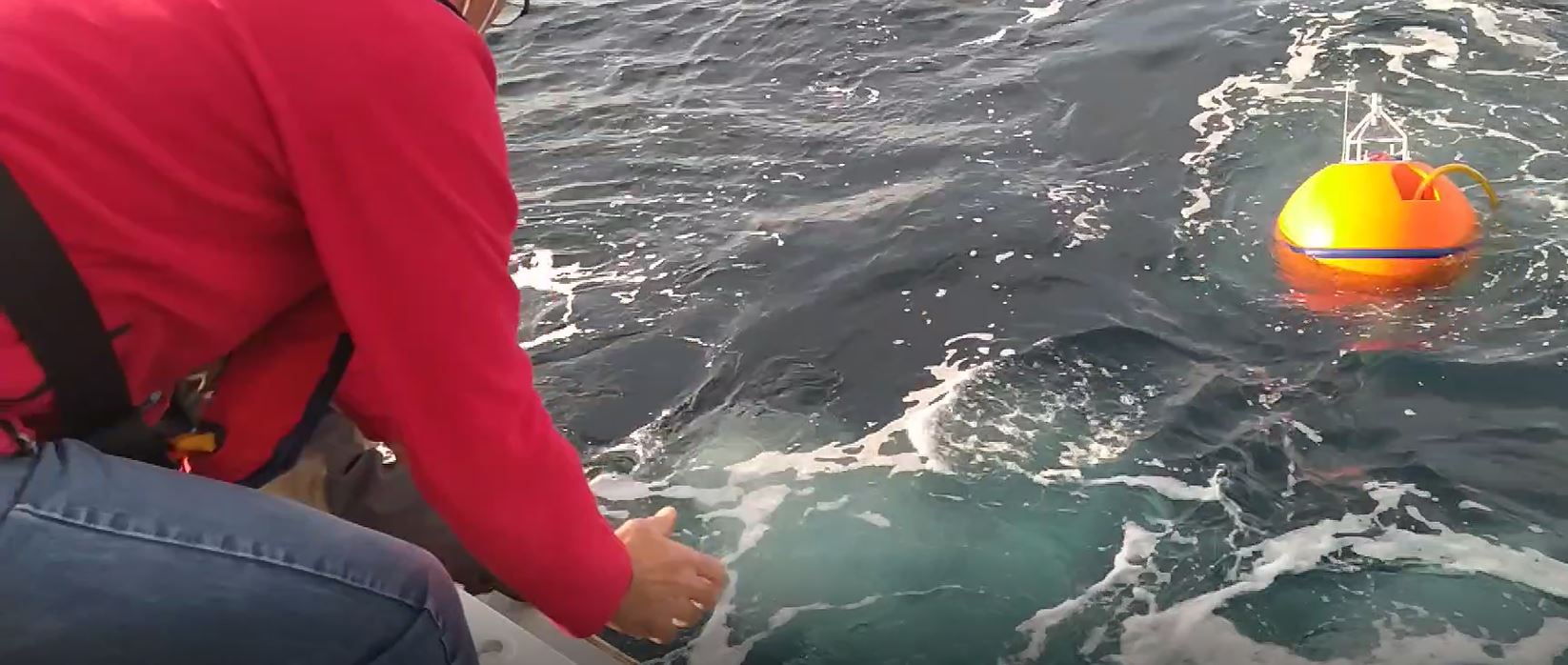
Launching of JULIO on Dec. 7, 2020
|
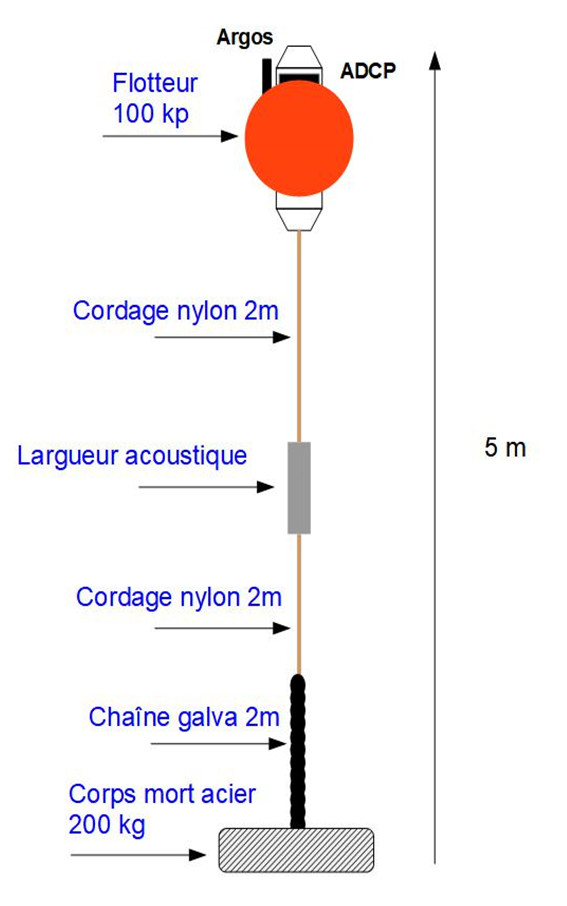
Schematics of the JULIO mooring (courtesy J.L. Fuda)
|
|
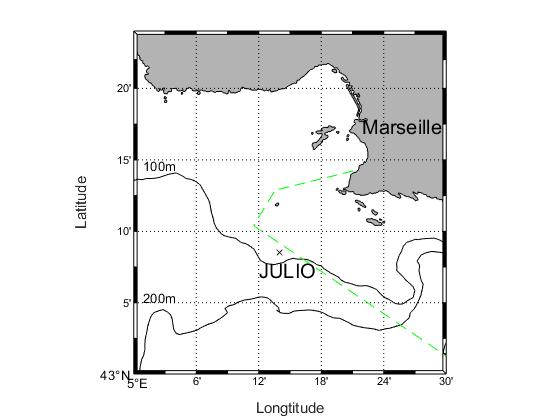
JULIO localization close to the Parc des Calanques
|
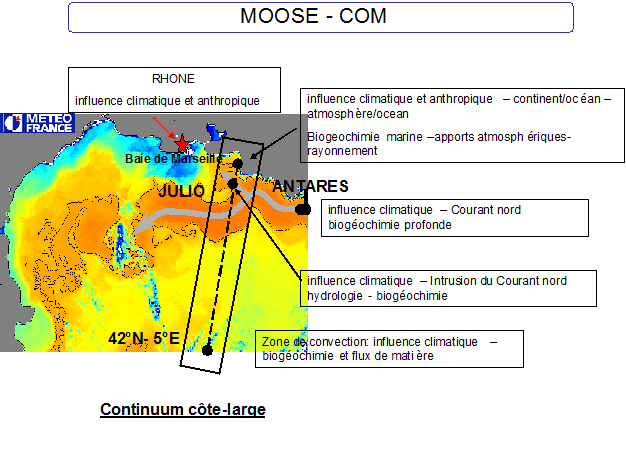
Localization of JULIO (COM's proposition to MOOSE in 2008 - 2009)
|
|
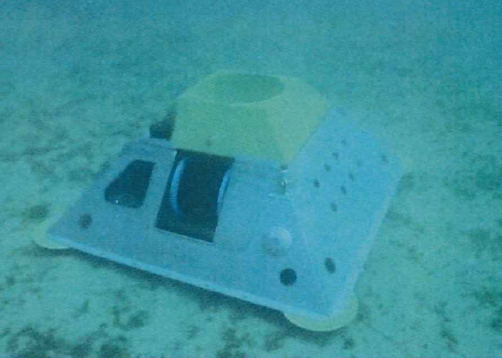
Anti-trawling JULIO mooring during 2012 - 2016
|
|
Historique:
- non inclus dans MOOSE Phase I en 2008 car changement de localisation par rapport à SOFI (PI C Grenz); donc non considérée comme série historique
- devait être inclus dans MOOSE Phase II en 2010 mais limitation budgétaire empechant la labellisation de nouveaux sites
- soutenu par programme SPECIMED (2012-2015; PI B. Quéguiner)
- soutenu par programme ROMARIN (2013-2018; PI C. Grenz)
Soutien permanent du MIO, de l'équipe physique: OPLC et SAM.
Readme instructions Balise Argos de JULIO










